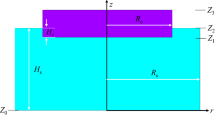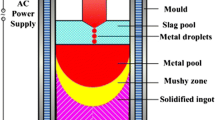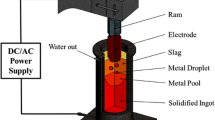Abstract
This article is devoted to the study of an important problem which arises during electroslag remelting when alternating current is converted to direct current. This problem arose in the second half of the last century but has not yet been solved, at least theoretically. However, experimental attempts to resolve it have always existed and continue to this day; moreover, they are quite successful. Due to the difficulties of studying physical phenomena in such processes, it is prudent to use mathematical modeling, in particular, using Maxwell’s theory of electromagnetism. The solution to the problem is to find the features of the behavior of electromagnetic fields in pools of slag melt. We analyzed the literature on this topic and formulated a number of hypotheses. Examination of these hypotheses using mathematical methods will allow for greater success in the direction of accepted assumptions. Rejected hypotheses are not subject to further consideration, thereby achieving significant savings in material and financial resources. Modeling is based on the Maxwell system of electromagnetism. The calculations revealed significant anisotropy in the redistribution of the main technological parameters, which corresponds to experimental data. Non-coaxialness sources of electric current lead to an increase in this anisotropy phenomenon.




Similar content being viewed by others
Data Availability
Not applicable.
References
Sirazetdinov TK (1977) Optimization of systems with distributed parameters. Nauka, Moscow
Andrienko SYu (1990) Peculiarities of physicochemical interaction during electroslag processes under conditions of intensive mixing of melts. Structure and properties of metal and slag melts: VII All-Union Conference. Chelyabinsk. V. 3. P. 2: 247.
Landau LD, Lifshits EM (2001) Electrodynamics of continuous media. Fizmatgiz, Moscow
Gorobets V, Bohdan Yu, Trokhaniak V, Antypov I (2019) Investigations of heat transfer and hydrodynamics in heat exchangers with compact arrangements of tubes. Applied Thermal Engineering, 151:46-54. https://doi.org/10.1016/j.applthermaleng.2019.01.059
Demidenko ND, Potapov VI, Shokin YI (2006) Modeling and optimization of systems with distributed parameters. Nauka, Novosibirsk
Jihe W, Yongli R (1994) Mathematical modeling of the slag flow field in the ESR system. Jinshu xuebao Acta met. sin. № 11.
Medovar BI (1978) Thermal processes in ESR. Science Dumka, Kiev
Cifuentes G, Cifuentes L, Crisostomo G (1998) A lead-acid battery analogue to in situ anode degradation in copper electrometallurgy. Corrosion Science, 40: 225-234. https://doi.org/10.1016/S0010-938X(97)00122-4
Nikitin VV, Garshin AS, Churkin AS (1990) Mathematical analysis of electroslag remelting processes on furnaces with adjustable current frequency. Mathematical methods and CAD in welding production: abstracts of conference reports. Sverdlovsk, p 29
Pyatygin DA, Porsev MA, Surov AN, Chumanov IV (2009) Parametric identification of the mathematical model of ESR. Bulletin of the South Ural State University. Series: Metallurgy. 36. (169): 28-30. https://elibrary.ru/item.asp?id=12999378
Liseikin VD (2007) Difference grids and coordinate transformations for the numerical solution of singularly perturbed problems. Nauka, Novosibirsk
Potapov VI (2003) The mathematical model of the wave process of metal crystallization. Materials of the VI International Conference of the BMT. Kursk. 112–115.
Nedopekin FV (1990) Mathematical modeling of hydrodynamic and thermophysical processes and thermophysical processes in the formation of ESR castings. News of Higher Educational Institutions, series "Ferrous Metallurgy", 3: 90-92.
Potapov VI, Igizianova NA (2005) Mathematical modeling of thermal and electromagnetic processes during electroslag remelting. Theory and technology of metallurgical production: a regional collection of scientific papers on the 100th anniversary of G.I. Nosov. MSTU, Magnitogorsk. 231–236.
Samarsky AA (1978) Methods for solving grid equations. Nauka, Moscow
Potapov VI, Andrianova RA, Vinogradov YN, Fetisova TM (2003) Search for optimal solutions by mathematical programming methods. SUSU, Chelyabinsk
Yoshi S, Mitchell A (1973) Electroslag remelting. Naukova Dumka, Kiev.:168–180
Nikitin VV, Garshin AS, Churkin AS (1990) Mathematical analysis of electroslag remelting processes on furnaces with adjustable current frequency. Mathematical methods and CAD in welding production: abstracts of conference reports. Sverdlovsk. 29.
Klyuev MM, Nikitin MM, Volkov SE (1984) Electroslag remelting. Metallurgy, Moscow
Igizianova NA, Potapov VI (2010) Volumetric electromagnetic forces in a current-carrying slag melt during ESR. XIV-th international scientific conference "Modern problems of steel electrometallurgy", Satka.
Igizianova NA (2014) The thermoelectrodynamic processes in high-temperature liquid non-metallic environments. St. Petersburg. https://doi.org/10.1109/Emission.2014.6893960
Jardy A, Ablitzer D, Wadier JF (1991) Magnitohydrodynamic and thermal behavior of electroslag remelting slags. Met. Trans. 1:111–120
Igizianova NA, Potapov VI, Chumanov IV, Pyatygin DA (2007) Electrodynamic processes in ESR on direct current and their mathematical modeling. Modern problems of steel electrometallurgy: materials of the XIII International Conference. SUSU. Chelyabinsk. 2:192–196
Funding
No funding was received for conducting this study.
Author information
Authors and Affiliations
Contributions
N.A. Igizianova contributed to the design and implementation of the research, to the analysis of the results and to the writing of the manuscript.
E.V. Sokolova performed the electronic calculations.
Corresponding author
Ethics declarations
Ethical approval
The article I have submitted to the International Journal of Advanced Manufacturing Technology for review is original, has been written by the stated authors and has not been published elsewhere.
The article is not currently being considered for publication by any other journal and will not be submitted for such review while under review by the International Journal of Advanced Manufacturing Technology.
The article contains no libelous or other unlawful statements and does not contain any materials that violate any personal or proprietary rights of any other person or entity.
Consent to participate
Not applicable.
Consent to publish
Not applicable.
Competing interests
The authors have no conflicts of interest to declare that are relevant to the content of this article.
Additional information
Publisher’s note
Springer Nature remains neutral with regard to jurisdictional claims in published maps and institutional affiliations.
Rights and permissions
About this article
Cite this article
Igizianova, N.A., Sokolova, E.V. Modeling electromagnetic processes in direct current electroslag remelting. Int J Adv Manuf Technol 113, 3189–3193 (2021). https://doi.org/10.1007/s00170-021-06787-z
Received:
Accepted:
Published:
Issue Date:
DOI: https://doi.org/10.1007/s00170-021-06787-z




